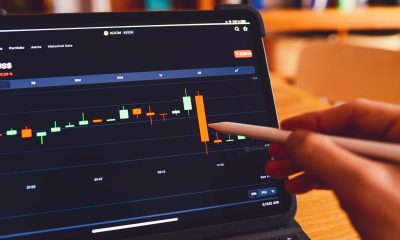Crypto
The most popular cryptocurrency is no longer Bitcoin
What’s the world’s most widely used cryptocurrency? If you think it’s Bitcoin, which accounts for about 70% of all the digital-asset world’s market value, you’re probably wrong. While concrete figures on trading volumes are hard to come by in this often murky corner of finance, data from CoinMarketCap.com show that the token with the highest daily and monthly trading volume is Tether.
If you think it’s Bitcoin, a cryptocurrency that accounts for about 70% of the world’s digital assets, you’re probably wrong. While specific trading volumes are difficult to find in this often gloomy corner of the financial world.
What’s the world’s best cryptocurrency?
CoinMarketCap.com data shows that the token with the highest daily and monthly trading volumes is Tether. The market capitalization of which is more than 30 times less than Bitcoin. For the first time, the trading volume of Tether exceeded the volume of Bitcoin in April. It constantly exceeded it since the beginning of August to about 21 billion dollars a day.
You can consider Tether the most important coin in the crypto-ecosystem as it is 18% higher than that of Bitcoin. It is also one of the main reasons why regulators are cautious about the cryptocurrency. They often seek to sell it on stock exchanges for fear of market manipulation.
If Tether suddenly disappears, we’ll lose a huge amount of daily transactions – about $1 billion or more depending on the source of the data,” said Lex Sokolin, co-head of global financial technology at ConsenSys, a blockchain technology company. – Some of the possible potential trading models in the market could begin to disappear.

Crypto-currencies with the highest daily trade volumes, in billions of dollars
Tether is the world’s most popular stable currency among tokens that seek to avoid price fluctuations, often using different bindings or reserves. That is why many traders choose it. According to Sokolin, in countries such as China, where cryptocurrencies are illegal, people can buy them for cash, getting rid of a few questions. Next, they can easily exchange them for Bitcoins and other coins, he said.
Tether, who faces a lawsuit in New York City for allegedly manipulating funds, including reserves, says the coin issuing and redemption requires a “know your customer” form and a transaction approval process.
According to Allaire, Asian traders account for about 70% of the total volume of cryptocurrencies. 40% and 80% of all transactions on the two leading global stock exchanges Binance and Huobi used Tether.
Tether, the new popular cryptocurrency
A lot of people don’t even know they’re using Tether. Most crypto exchanges still do not have bank accounts and cannot hold dollars on behalf of customers because traditional financial institutions worry that they are not good enough at catching criminals and money launderers. That’s why they use Tether as a substitute, Thaddeus Dreyer, a researcher at the Massachusetts Institute of Technology said.
The way Tether handles it makes it a black box. Although Bitcoin belongs to nobody. Tether comes from a private company in Hong Kong, the owners of which also own a Bitfinex crypto exchange. The exact mechanism by which the Tether balance increases and decreases is unclear. They are absorbed by the fiat reserves, as the cryptocurrency is not independently verified.
In April, Tether disclosed that only 74% of Tether is cash and short-term securities. Disclosure as part of an ongoing investigation by the New York City attorney general, who accused the company of trying to conceal the loss of $850 million in client and corporate funds.

Convenience against risk
The currency controlled from a single center is damaging to the original purpose of blockchain and the decentralization of cryptocurrencies,” Griffin said. – Avoiding government authority, stable cryptocurrencies instead place trust in the hands of large technology companies, which have mixed responsibilities. Thus, while the idea is excellent in theory, in practice it is risky, open to abuse, and suffers from problems similar to traditional paper-based ones.
On the other hand, because Tether is the key to their growth, many cryptographic exchanges are likely to help it out if necessary,” said Dan Reichmann, who develops the digital asset platform and previously headed Galaxy Digital’s trading technology department.
“All these exchanges provide indirect support, which helps Tether stay afloat,” he explains. A lot of stable crypto-currencies passed independent testing and regulation, Tether remains the favorite for today. Tether has been in existence since 2014. The time when the crypto predecessors appeared. It has still retained its value.
__
(Featured image by Dmitry Demidko via Unsplash)
First published in business-vector, a third-party contributor translated and adapted the article from the original. In case of discrepancy, the original will prevail.
Although we made reasonable efforts to provide accurate translations, some parts may be incorrect. Born2Invest assumes no responsibility for errors, omissions or ambiguities in the translations provided on this website. Any person or entity relying on translated content does so at their own risk. Born2Invest is not responsible for losses caused by such reliance on the accuracy or reliability of translated information. If you wish to report an error or inaccuracy in the translation, we encourage you to contact us.

-

 Cannabis1 week ago
Cannabis1 week agoMedical Cannabis vs Street Weed: Why Therapy Makes More Sense in 2025
-

 Markets3 days ago
Markets3 days agoGold, Liquidity, and Market Complacency Heading Into 2026
-

 Cannabis22 hours ago
Cannabis22 hours agoAgential Cannabis 2026 Set to Spotlight Southeast Asia
-

 Impact Investing1 week ago
Impact Investing1 week agoCOP30: Fragmented Climate Politics, Multi-Speed Transition, and Emerging Investment Opportunities
























